Bulletin – June 2017 Financial Stability How Have Australian Banks Responded to Tighter Capital and Liquidity Requirements?
- Download 955KB
Abstract
Australian banks have responded to tighter regulatory requirements for capital and liquidity over the past decade, which has strengthened their resilience to adverse shocks. While banks are now in a much better position to deal with these types of shocks, this strengthening has also had implications for their funding costs and some key profitability metrics. This article outlines some of the main changes to banks' activities as they have responded to the tighter capital and liquidity requirements.
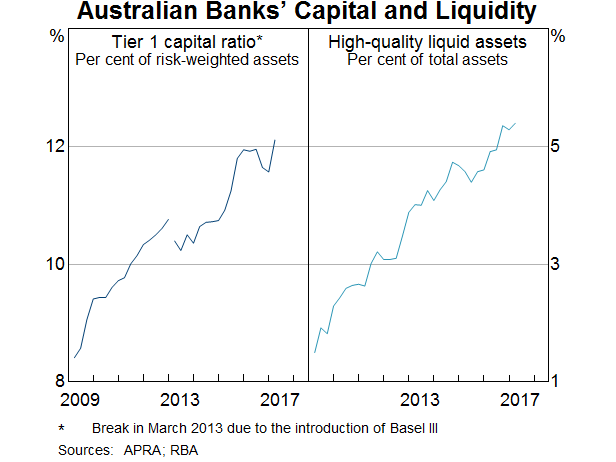
Introduction
Since the financial crisis in 2008–09, regulatory authorities, financial institutions and financial markets globally have increasingly focused on risk and resilience in the banking sector. Banks assume a range of risks through their lending activities. These include liquidity risk arising from maturity transformation – borrowing short and lending long – and credit risk from their lending activities. Banks can build resilience against these risks by managing their capital and liquidity positions.
The financial crisis highlighted that banks in many countries had not always managed the risks associated with their activities appropriately. In response, the Basel Committee on Banking Supervision revised its international framework of regulatory standards in order to improve the resilience of the global financial system. The revised framework increased capital requirements and introduced minimum liquidity standards. As a result, the framework shifted from focusing mostly on the risk-weighted capital ratio to also considering a range of other risk measures and management policies.[1] Some of the main changes to the international framework were to:
- increase the amount and quality of capital (including through capital buffers and cyclical macroprudential capital tools, such as the countercyclical capital buffer)[2]
- introduce a non-risk-weighted leverage ratio, a simple and transparent measure of risk
- introduce a liquidity coverage ratio (LCR), which provides a buffer against short-term liquidity stress by requiring a greater amount of high-quality liquid assets (HQLA) to be held
- introduce a net stable funding ratio (NSFR), which promotes resilience to more sustained liquidity pressures by encouraging banks to fund assets with stable sources of funding.[3]
In addition to these global changes, the 2014 Financial System Inquiry made a number of recommendations to strengthen the Australian financial system. These included that capital standards be set so that Australian banks' capital ratios are ‘unquestionably strong’, and that the average risk weight on Australian mortgages calculated using the internal ratings-based (IRB) approach to credit risk be increased, so that they are closer to the risk weights set under the standardised approach.
In response, the Australian Prudential Regulation Authority (APRA) has implemented several changes to its capital and liquidity requirements. These include introducing the LCR requirement in 2015, establishing additional capital buffers (including a countercyclical capital buffer policy), and implementing a higher minimum average mortgage-risk weight for banks using the IRB approach, which came into effect from mid 2016. In addition, IRB banks are required to disclose their non-risk-weighted leverage ratios while the standards are finalised, and new requirements for the NSFR will become binding from 2018. APRA has indicated that it will publish its view shortly on how ‘unquestionably strong’ can be measured. Furthermore, APRA, supported by the other agencies of the Council of Financial Regulators, has intensified its supervision of the sector since the financial crisis and introduced new measures to address emerging risks in areas not already captured by the regulatory framework. The remainder of this article outlines some of the main changes to the activities of Australian banks as they have adapted to these changes in capital and liquidity requirements.
The Strengthening of Australian Banks' Capital Position
A bank's capital provides it with the ability to absorb losses, making it a core part of their resilience against adverse shocks. Capital is more expensive than other types of funding because investors require additional compensation since it bears losses first. As a result, banks have an incentive to optimise the amount of capital on their balance sheets. The amount of capital held by a bank is most commonly measured as a ratio to its risk-weighted assets.
Australian banks have substantially increased their capital ratios since the financial crisis. The total capital ratio of the Australian banking system has risen by 3¾ percentage points since the start of 2008, and currently stands at 14¼ per cent (Graph 1). The quality of banks' capital has also improved. In particular, Common Equity Tier 1 (CET1) capital – the highest quality form of capital – has accounted for most of the rise in total capital since it was introduced as a minimum requirement in 2013.[4] The combined CET1 capital ratio of the major Australian banks appears to have also strengthened relative to international banks more recently, and it is estimated to now be in the top quartile of the global distribution. Overall, Australian banks have a substantial buffer above APRA's minimum regulatory capital requirements.[5]
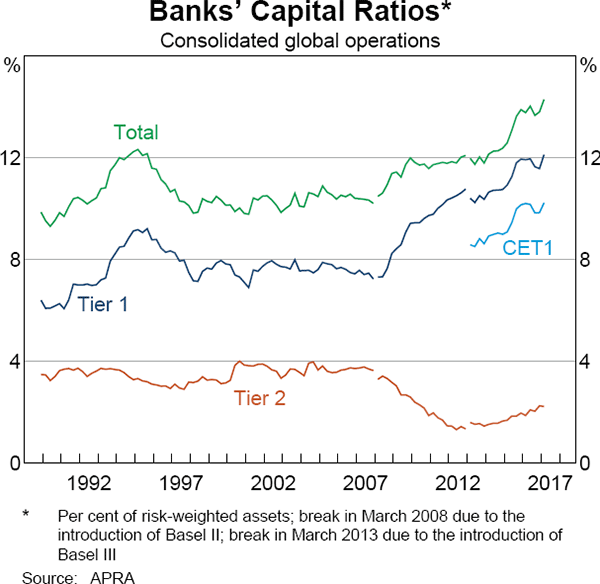
Banks have used a range of methods to increase their capital base. These have included the accumulation of retained earnings, dividend reinvestment plans (DRPs) and new equity issuance – with broadly similar amounts raised through each of these methods since 2008 (Graph 2).[6] Since the financial crisis, there has been a fairly steady increase in retained earnings and equity from DRPs, while new equity issuance was mainly used immediately after the financial crisis and then again in the second half of 2015. Retained earnings have contributed a small amount to capital over the past two years as profits have been little changed.
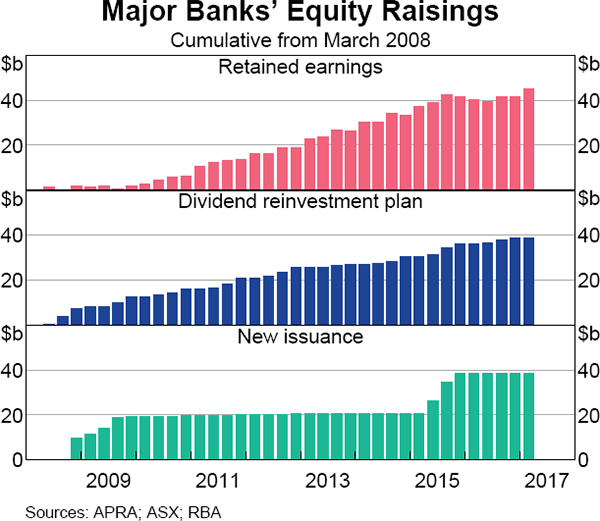
This increase in capital has had a direct effect on banks' return on equity (ROE). Australian banks' ROE remains high by international standards, but the rise in bank capital since 2008, combined with lower profit growth, has reduced ROE to below its pre-crisis levels (Graph 3). While this increase in capital has reduced banks' leverage and should make them more resilient, this does not appear to have been reflected in a lower implied risk premium demanded by investors (Norman 2017). As a result, banks' price-to-book ratios have also declined. Looking ahead, ROE will probably remain below its historical levels as banks accumulate more capital to meet previously announced future requirements. In acknowledgement of these developments, some banks have either moved away from or lowered their explicit ROE targets.
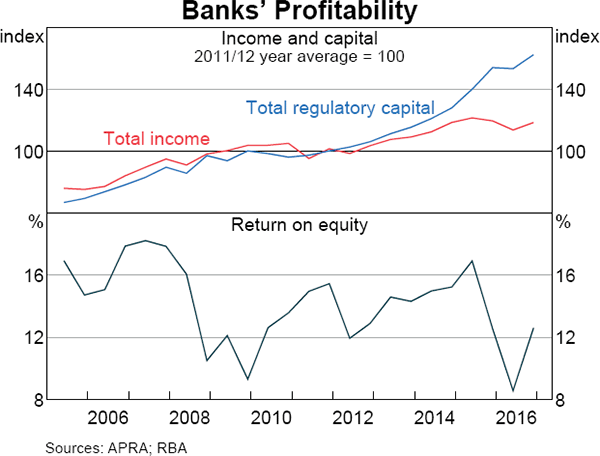
Banks have responded to the higher capital requirements by adjusting their lending activities. In particular, they have increasingly focused on activities that generate higher returns for a given amount of capital to help support ROE. Consistent with this, banks have limited the required increase in capital as they have grown their balance sheets over the past 10 years by reducing the average risk weight of their assets (Graph 4). (This is despite a recent rise in the average risk weight associated with APRA increasing the capital requirement for Australian mortgages under the IRB approach.) Overall, the decline in the average risk weight of Australian banks' assets has had the effect of supporting capital ratios to meet higher capital requirements while lessening the effect on ROE.[7]
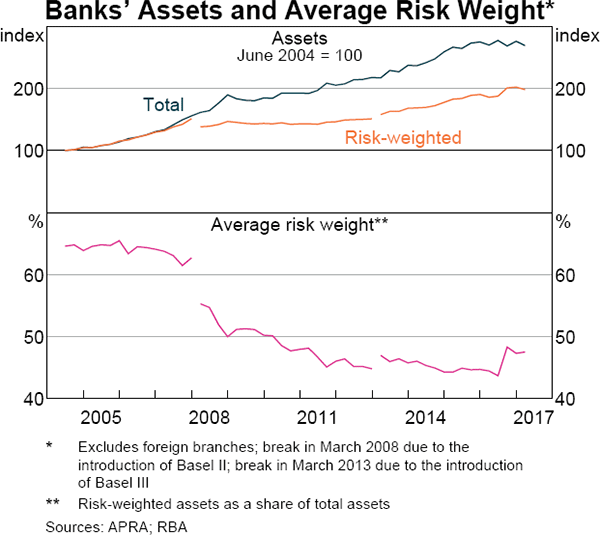
One of the most notable ways that banks have been able to reduce their average risk weight, and the effect of higher capital on ROE, has been through a continued shift towards housing lending. In 2016, housing credit accounted for almost two-thirds of the stock of banks' domestic credit, up from a bit above half in 2008 and well above the level from a couple of decades ago (Graph 5). This long-run trend has been underpinned by factors such as financial deregulation and competition in lending markets, a permanent decline in inflation and an increase in the cost of housing relative to business assets over time; more recently, low interest rates appear to have encouraged housing investment and demand for housing credit, while businesses have been reluctant to invest. Nonetheless, one reason that banks have accommodated the strong demand for housing credit may have been that housing lending has been able to generate higher ROE than other types of lending, because the lower risk weight applied to mortgages has not been fully offset by narrower credit spreads.[8]
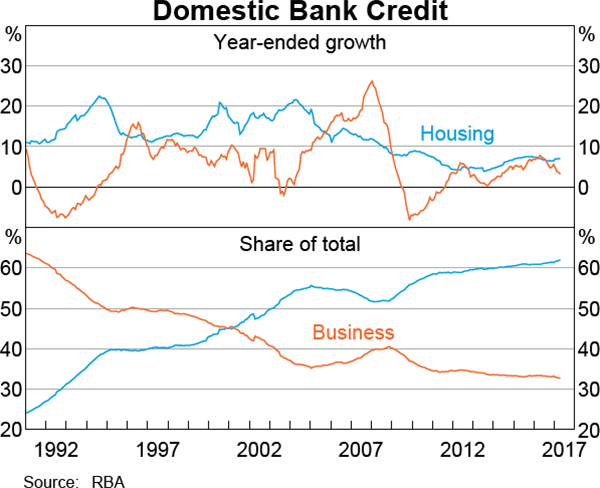
Some banks have also been scaling back lending activities that are more capital intensive but do not generate sufficient returns (for the amount of capital required). This has included some international activities (outside of New Zealand), institutional lending and trade finance exposures. Most notably, NAB sold its UK subsidiary in early 2016 and ANZ and others have been progressively reducing their exposures to institutional lending and trade finance activities. Most of the major banks have also sold (or are in the process of selling) parts of their wealth management businesses. As discussed in Golat (2016), the income generated by these businesses has often fallen short of initial expectations and they have generated lower returns than core banking activities.
Banks have also responded to higher capital requirements by repricing their loans, most notably housing loans. Since mid 2008, the cash rate has declined by 575 basis points while housing lending rates have declined by around 390 basis points (Graph 6). While part of the widening in this spread has been due to a rise in banks' funding costs relative to the cash rate, the implied spread between banks' mortgage lending rates and their funding costs has still increased by around 110 basis points. Part of this increase in spreads reflects efforts by banks to offset the costs associated with using more equity to fund lending as capital requirements have increased. The remainder likely reflects banks' efforts to offset the impact on their earnings from new regulations requiring them to hold a greater amount of HQLA, which typically have a yield that is less than the cost of funding (as discussed below). More recently, banks have increased their lending rates on investor and interest-only loans, relative to those on amortising owner-occupier loans, in response to regulatory measures regarding these types of loans.[9]
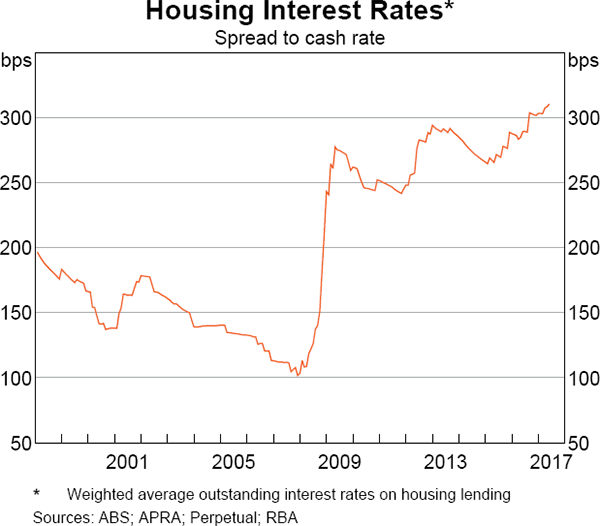
The Strengthening of Australian Banks' Liquidity Position
A second important component of resilience is banks' ability to withstand a withdrawal of funding. As noted earlier, banks assume liquidity risk by engaging in maturity transformation. Banks generally write long-term loans while banks' creditors generally lend to banks for shorter periods of time. As a result, the average maturity of a bank's assets is much longer than the average maturity of its liabilities (Graph 7). This means banks are exposed to the risk that they will need to repay some liabilities ahead of their assets maturing. Banks earn income from taking on this risk – it accounts for part of the spread between the interest rates on their assets and liabilities. However, the financial crisis highlighted that many banks internationally had not adequately protected themselves against liquidity shocks, such as disruptions in funding markets.
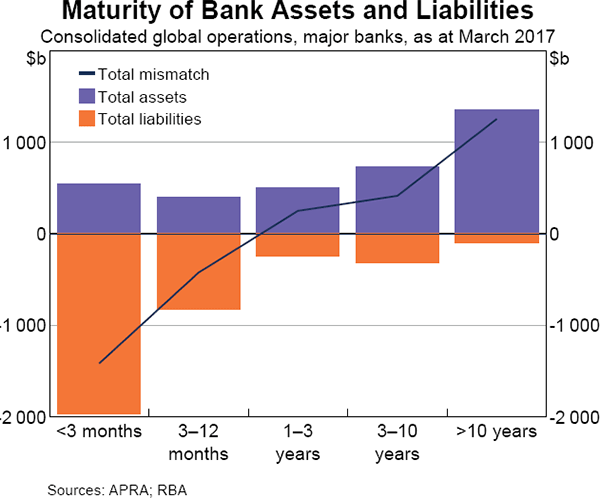
Regulators responded to these lessons from the crisis by introducing new prudential liquidity requirements. These requirements are designed to ensure that banks meet minimum standards regarding the amount of liquidity risk that they can assume and that they hold stronger buffers in case of liquidity shocks (Debelle 2015). These prudential requirements, and a reassessment of banks' liquidity positions more broadly, have seen Australian banks increase their funding from more stable sources such as deposits, equity and long-term wholesale debt, while sourcing a lower share of funding from short-term wholesale markets and securitisation (Graph 8).
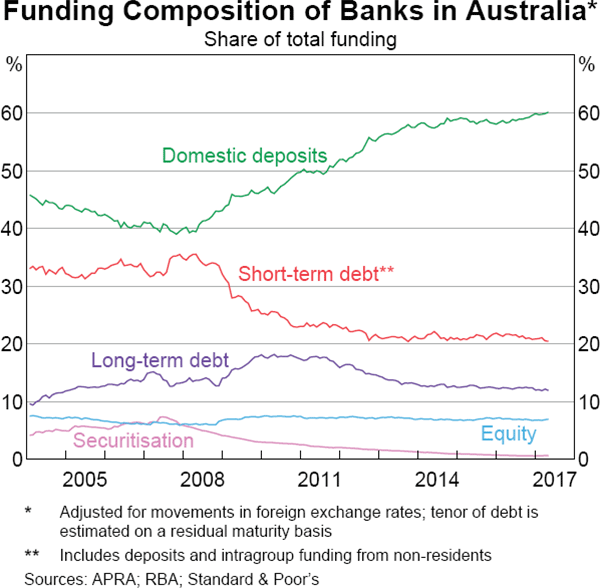
Two new liquidity requirements introduced since the crisis are the LCR and the NSFR.[10] The LCR was implemented in Australia in 2015, but banks began adjusting to this change well ahead of this date. It requires banks to hold a buffer of HQLA to cover net cash outflows in a 30-day stress scenario. Since its introduction in 2015, the average LCR across banks that are subject to the requirement has increased from around 120 per cent to around 130 per cent.
The NSFR, which comes into effect in Australia in 2018, requires banks to hold a minimum level of stable funding against their assets and off-balance sheet activities. Stable funding includes equity, long-term debt and sticky deposits such as those from retail customers or small to medium-sized enterprises who have a number of different products with the same bank. The intention is to ensure that banks do not take on an excessive amount of liquidity risk over a one-year horizon. Banks have been preparing for the introduction of the NSFR over the past year or so, primarily through changes to their liability structure, and most have reported that they are already compliant.
These regulatory changes have caused banks to make adjustments to their liability structures, asset holdings and liability pricing. Each of these is discussed in turn.
Changes to bank liabilities
Banks have responded to liquidity requirements by substituting between different types of liabilities, and towards liabilities with longer maturities. Changes to banks' mix of liabilities can have a large effect on the amount of liquidity risk they assume. For example, short-term wholesale debt is generally a less stable form of funding and replacing it with longer-dated funding strengthens banks' liquidity positions. Similarly, increasing the share of equity funding strengthens banks' liquidity positions, since equity is a permanent form of funding. Under the LCR and NSFR, the counterparty from whom funding is sourced is also relevant to how stable that funding is considered to be.
Banks have lengthened the maturity of their liabilities by seeking a greater amount of term deposit funding over the past year (Graph 9). These types of deposits have a longer maturity, which means they are more stable and are less likely to be withdrawn than at-call deposits. Further, banks have increased the average maturity of their term deposit funding, particularly through the second half of 2016.
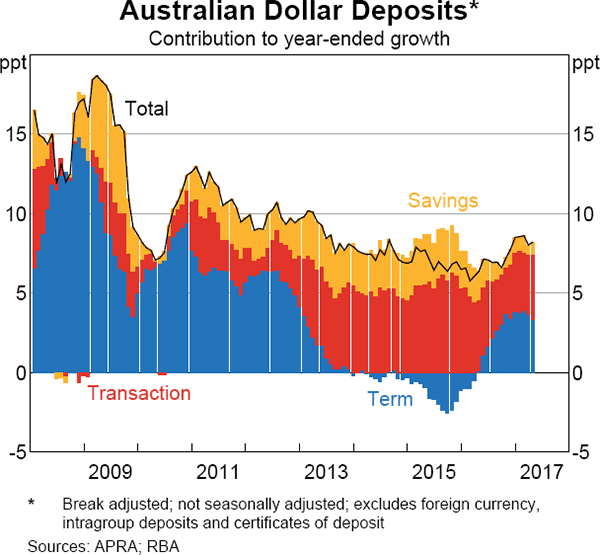
Banks have also changed the contractual nature of some deposit products to ensure that they cannot be broken within 31 days of maturity (except in hardship cases). These changes were made around late 2014 and were motivated by the impending introduction of the LCR.
Moreover, banks have lengthened the average maturity of their wholesale funding by increasing the share of long-term wholesale debt at the expense of short-term wholesale debt (Cheung 2017). In addition, they have increased the average maturity of new issuance of both short-term and long-term wholesale debt. Over the past year, the average term of long-term wholesale debt issuance was around one year longer than its historical average. Similarly, banks have lengthened the average maturity of their short-term debt by issuing securities with longer terms and buying back these securities as they approach maturity. Wholesale debt issuance with short maturities is a relatively unattractive source of funding for banks since they have to hold low-yielding HQLA against this funding. Reflecting this, issuance of bank bills with a one-month maturity has largely ceased, after previously accounting for up to one-quarter of the market.
Another way that banks have responded to changes in liquidity requirements is by sourcing less funding from customers such as large corporations and financial institutions. In general, at-call wholesale deposits are viewed as a less stable form of funding than at-call retail deposits, which are more likely to be fully supported by the government guarantee under the Financial Claims Scheme (that protects deposits up to $250,000 for each account holder at each authorised deposit-taking institutions (ADI)). Banks have also changed the contractual terms of at-call wholesale deposits to effectively increase the maturity of these products. For instance, many deposits from large corporates and financial institutions can only be withdrawn after a period of notice has been provided, typically in excess of 30 days.[11]
Another distinction between different at-call deposits is made on the basis of whether the deposit is used for transactional or savings purposes. Transactional (or operational) deposits are considered more stable since they are used by the depositor to make and receive payments, and a minimum balance is typically maintained to support these payments. Bank demand for these comparatively more stable deposits has increased relative to less stable at-call saving deposits that are more sensitive to changes in interest rates (given the sole purpose of these funds is to generate a return for the customer).
Changes to bank assets
While much of the adjustment to the amount of liquidity risk that banks assume has come through changes to banks' liabilities, banks have also made some adjustments to their assets. The main change to asset composition prompted by the new liquidity regulations has been an increase in holdings of HQLA that can be used as a buffer against liquidity shocks.
The LCR requires banks to hold sufficient HQLA to fund their expected net cash outflows through a 30-day period of stress. Consequently, banks have increased their holdings of HQLA as a share of their assets. Australian dollar-denominated HQLA securities are now about 5 per cent of banks' total assets, up from around 1 per cent in early 2008 (Graph 10). Securities eligible as HQLA include Australian Government Securities (AGS) and state government securities (semis). Because of the relatively small pool of government paper that could be used as HQLA, Australian banks subject to the LCR meet around half of their Australian dollar HQLA requirements via the Committed Liquidity Facility (CLF). The CLF is a contractual, secured liquidity facility offered by the Reserve Bank which, for a fee of 15 basis points per annum (regardless of whether it is drawn), covers any shortfall between the ADI's holdings of HQLA and the LCR requirement. The presence of this facility has ensured the LCR does not create excessive demand for AGS and semis and has limited banks' need to increase their HQLA holdings more substantially. In past years, as outstanding government debt has increased and net cash outflows have generally declined, the size of the CLF has been reduced.
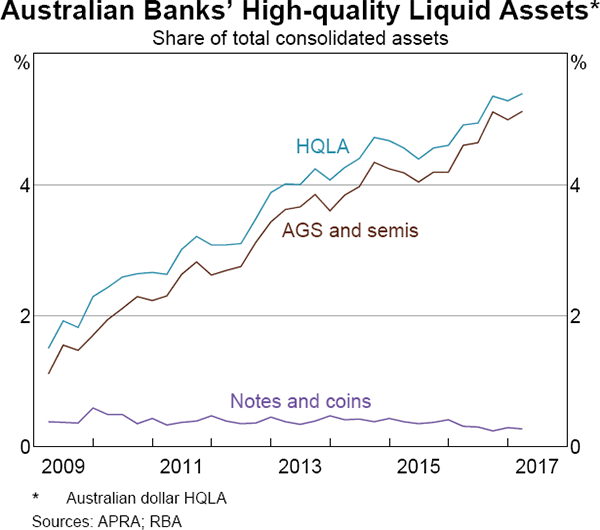
Pricing changes
The changes in banks' demand for different assets and liabilities have also affected the interest rates on these products, though the direct effects attributable to the liquidity value of these products are difficult to disentangle from other price movements. The change in banks' funding mix towards more stable funding sources has, by itself, increased the cost of funding, which has been passed on to many borrowers.
Relative price changes across banks' deposit offerings have been extensive over the past few years, particularly since the introduction of the LCR, as different deposits have a different liquidity value to the bank. Most notably, banks have increased the interest rates on term deposits relative to other deposits and wholesale funding rates, both immediately after the financial crisis and again in preparation for the impending introduction of the NSFR (Graph 11). Interest rates on online saver accounts – where customers get rewarded for making regular deposits – have also risen in response to their regulatory treatment. Banks have also competed for transactional (or operational) banking relationships through improved service levels, product bundling and fees. For example, a product offering that has recently been popular with customers has been a home loan bundled with an offset account and a credit card, with the funds in the offset account considered to be stable deposits.
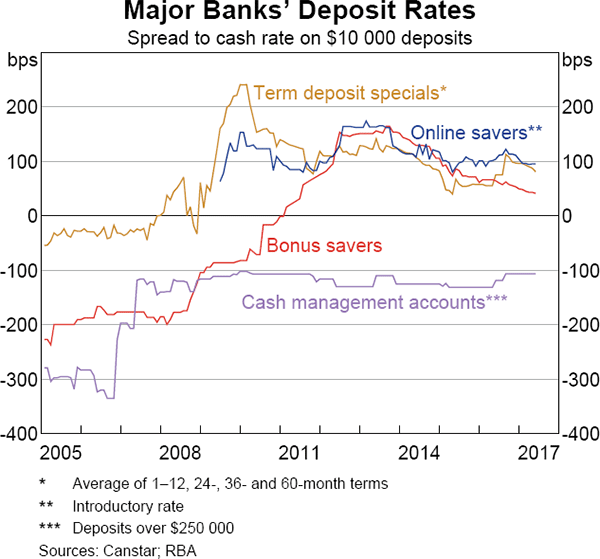
Changes in bank demand for different sources of funding have also influenced the interest rates on some wholesale debt instruments. The switch in bank demand from wholesale funding with a maturity of less than 30 days to wholesale funding with a maturity of 90 or 180 days has contributed to a widening in the interest rate spreads on these longer-dated bills since 2014 (Graph 12). In contrast, increased bond issuance by banks (which are price takers in offshore markets, where a significant share of the wholesale debt of Australian banks is issued) has been absorbed without price impact, supported by favourable market conditions and the depth of those markets.
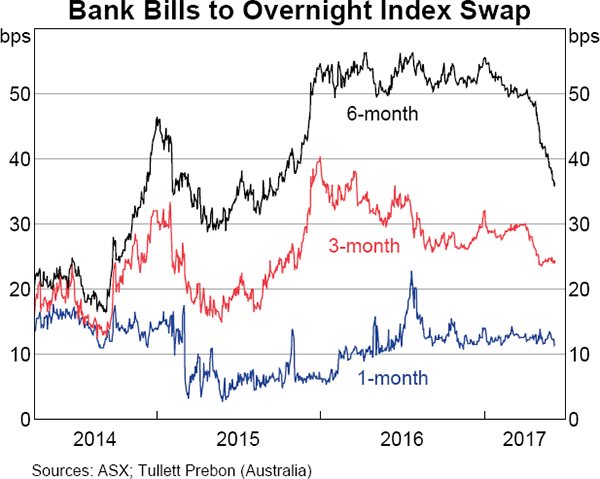
The new liquidity standards also require banks to demonstrate an internal liquidity transfer pricing model, which fully reflects the liquidity cost in the price of various products they offer customers. This has resulted in a change in the price (or terms) of a number of lending facilities, such as lines of credit and the cost of offering longer-term business loans. For instance, an increase in the typical maturity of a class of loan over time, such as a mortgage, will result in it being assigned a higher liquidity cost. Looking ahead, further changes in the relative prices of liabilities and assets are likely as banks continue to assess the liquidity value of their different assets and liabilities. For example, if retail depositors can more easily switch bank accounts over time, then these deposits might attract lower interest rates as they would be a less stable funding source to a bank.
Conclusion
Stronger capital and liquidity positions improve banks' resilience against adverse shocks. However, such changes can also affect their funding costs and key profitability metrics. Australian banks have responded to increased capital requirements by strengthening their capital position, primarily through an increase in common equity. This has contributed to a decline in ROE, which has encouraged banks to make some changes to their lending activities. These changes have included a continued shift towards housing lending, a scaling-back of capital-intensive and lower-return lending, and a repricing of loans. Banks have also strengthened their liquidity position in response to tighter liquidity requirements and a more general reassessment of risk. This has contributed to a repricing of deposit liabilities, a lengthening of the maturity of liabilities more generally and a continued shift towards more stable sources of funding. Liquidity regulations have also driven a shift in asset composition towards government securities. While the upcoming introduction of the NSFR and ‘unquestionably strong’ capital framework is likely to have already had some effect on banks' activities, it is likely there will be further adjustments from banks as they fully respond to the revised capital and liquidity requirements.
Footnotes
The authors are from Financial Stability Department and Domestic Markets Department. [*]
See Edey (2011) for an overview of the changes to the Basel III framework. [1]
For more detailed information on capital reforms and their implementation in Australia, see RBA (2013). [2]
For more detailed information on liquidity reforms and their implementation in Australia, see RBA (2015). [3]
Australian banks' total regulatory capital consists of Tier 1 and Tier 2 capital. Within Tier 1 capital, banks are required to maintain a minimum amount of CET1 capital with the remainder able to be made up of Additional Tier 1 capital. [4]
Banks are required to maintain a minimum total capital ratio of 8.0 per cent, a Tier 1 capital ratio of 6.0 per cent and a CET1 capital ratio of 4.5 per cent. Banks must also maintain a minimum 2.5 per cent capital conservation buffer of CET1 capital (plus an additional 1 per cent for the four domestic systemically important banks). [5]
DRPs are where shareholders reinvest their dividends in return for an increased equity holding. [6]
While the decline in the average risk weight has been mostly driven by changes in the composition of lending, regulatory changes have also contributed, including the introduction of Basel II. [7]
The average risk weight applied to housing exposures at the major banks (estimated using internal models) is roughly half that applied to corporate exposures, even after accounting for APRA's recent increase to mortgage risk weights. The difference in risk weights reflects lower loss rates for housing exposures compared with corporate exposures. [8]
See RBA (2017, p17) for more information on regulatory measures to reinforce sound housing lending practices. [9]
These prudential requirements apply only to banks that are larger and more complex with respect to their liquidity risk. Other authorised deposit-taking institutions (ADIs) must ensure that their liquid assets are equivalent to at least 9 per cent of their liabilities. [10]
Similar deposit offerings with notice periods have been extended to retail depositors, although they only account for less than 5 per cent of at-call deposit funding. [11]
References
Cheung B (2017), ‘Developments in Banks' Funding Costs and Lending Rates’, RBA Bulletin, March, pp 45–50.
Debelle G (2015), ‘Some Effects of the New Liquidity Regime’, Speech at the 28th Australasian Finance and Banking Conference, Sydney, 16 December.
Edey M (2011), ‘Basel III and Beyond’, Speech at the Basel III Conference 2011, Sydney, 24 March.
Golat T (2016), ‘Banks' Wealth Management Activities in Australia’, RBA Bulletin, September, pp 53–59.
Norman D (2017), ‘Returns on Equity, Cost of Equity and the Implications for Banks’, RBA Bulletin, March, pp 51–58.
RBA (Reserve Bank of Australia) (2013), ‘Box B: The Basel III Capital Reforms in Australia’, Financial Stability Review, September, pp 36–38.
RBA (2015), ‘Box A: The Basel III Liquidity Reforms in Australia’, Financial Stability Review, March, pp 32–34.
RBA (2017), Financial Stability Review, April.